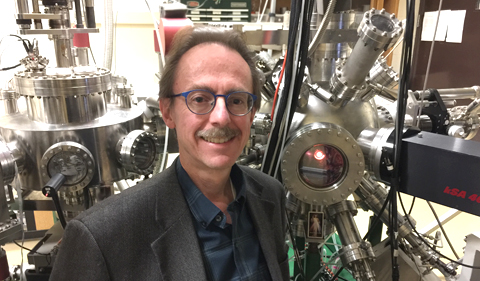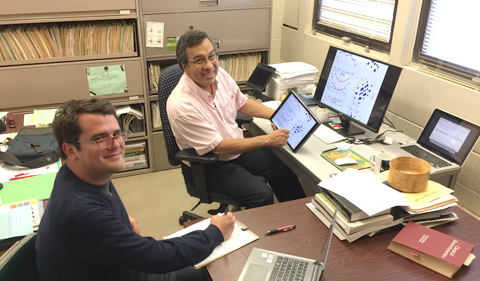Ohio University physicists Dr. Arthur R. Smith and Dr. Sergio Ulloa have published side-by-side papers about understanding of the chemical compound chromium nitride, a material with a number of interesting but fairly controversial electronic, magnetic, and structural properties.
Ulloa and Smith are members of OHIO’s Nanoscale and Quantum Phenomena Institute.
Chromium nitride (CrN) is traditionally used as a super hard coating material for wear (or corrosion) resistant applications, such as coatings in fuel cells. More recently, there is interest in CrN as a possible material to be used for spintronics, a technology melding magnetism and electronics; so CrN devices might be used in future computer memory applications.
However, while it is believed that its electronic and magnetic properties are intertwined, reports have varied widely regarding these very properties, some research claiming the material to be electrically insulating, some that it is highly conductive, some arguing it is strongly magnetic, and some saying it is hardly magnetic at all.
The two separate but complementary efforts led by Ulloa and Smith have resulted in a better understanding of the magneto-structural phase behavior and phase transitions of CrN thin films. Both articles were written in collaboration with external partners, and each published this month in the journal Physical Review B, the American Physical Society’s journal dedicated to topics in condensed matter physics.
Antiferromagnetism Found in CrN Thin Films
Smith’s team involved experimentalists from OHIO and the National Institute for Standards and Technology, as well as theoreticians from the National University of Mexico in Ensenada, Baja California, and the University of Puebla, in Mexico.
In their paper ‘Structural and magnetic phase transitions in chromium nitride thin films grown by rf nitrogen plasma molecular beam epitaxy,’ the researchers definitively determined that high quality CrN thin films grown by molecular beam epitaxy on crystalline magnesium oxide substrates undergo clear first-order phase transitions to an antiferromagnetic state below a Neel temperature near 280 K.
This is an important advancement for the field since future device applications will require having the magnetically active CrN in thin film form, which has been difficult to achieve by other labs.
Led by Ohio University alum and Smith’s former physics doctoral student Dr. Khan Alam ’16Ph.D., the team presented temperature-dependent electron diffraction measurements conducted in Smith’s lab and temperature-dependent neutron diffraction measurements done at the National Institute of Standards and Technology in Gaithersburg, Maryland. Co-authors from OHIO include graduate student Andrea Richard, Smith’s former doctoral student alum Andrew Foley ’17Ph.D., and Dr. David Ingram, Professor and Chair of Physics & Astronomy.
In addition, the work includes first principles calculations done by visiting physics doctoral student Rodrigo Ponce-Perez from the University of Puebla and his advisers, Noboru Takeuchi and Gregorio H. Cocoletzi, who have a long-standing collaboration with Smith and his group.
Smith’s paper also considered, both from an experimental as well as theory point of view, possible models for the low temperature state, taking into consideration cubic, tetragonal, and orthorhombic crystal geometries.
“In contrast to prior publications in the field,” Smith says, “Our collaborative work clearly reveals a close connection between the structural and magnetic transitions in this material. This is exciting because while prior theory predicted this connection, it has been difficult to verify experimentally.”
Smith’s research is supported in part by the U.S. Department of Energy, Office of Basic Energy Sciences.
Chromium Nitride Under Strain
In an independent theoretical study, ‘Strain fields and electronic structure of antiferromagnetic CrN’ by Tomas Rojas Solorzano, a doctoral student in Physics and Astronomy, and Ulloa investigated how elastic strains of up to 2 percent along various crystalline directions within the CrN material can affect its electronic properties.
Their computational approach looked at the electronic structure for different models and calculated effects of strain on the possible presence of an energy gap, finding that strain can cause the material to cross between a metal and a small-gap semiconductor.
They also found that strains along different directions affect the effective masses of electrons and holes unequally, which in turn could play an important role in a variety of transport measurements done on real samples.
In addition, they showed that different crystalline models exhibit similar but uniquely different properties.
“These effects could potentially explain some of the discrepancies in experimental results previously reported,” says Rojas, “since the electronic properties of CrN thin films grown by various techniques and on different substrates have different strain patterns created during the growth process.”
Understanding the electronic and magnetic properties of novel materials such as CrN crystals may have important consequences in spintronics in terms of the manipulation of magnetic properties through electronic means.
“Efforts at Ohio University and elsewhere are paving the way for future devices operating under a different paradigm, and we are glad to be contributing to these developments,” says Ulloa.
Ulloa’s research is funded in part by the National Science Foundation.





















Comments